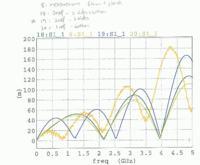sherry20
Junior Member level 3
I'm running a simulation for a 50ohm transmission line in Momentum, and have been trying several ways to setup the port. This is an exercise for me to have a better understanding on how to set up simulations in Momentum.
The structure is shown below. The signal line thickness is 52.5um, width is 635um, gap width on either side is also 635um. Dielectric thickness is 304um, epsilon_r=3.38. Bottom metal thickness is 35um, but in Momentum, it's set as a sheet.

For the three port setup I tried, I got different results. What bothers me is the additional null shown in the case with 2 references.

My questions are:
1) Among the 3 port setups I've tried, what is the correct/mostly used way to set up a port in this type of problem?
2) Why is the additional null show up in one case but not the other two? The fact that it also shows up in the measurement makes me believe it's the correct answer out of the three. My guess is there's some parasitic mode being excited, but I can't provide a good explanation of the phenomena.
3) What could be some test cases which are easy to set up in simulation tool, and the theoretical solutions also exist? I try to get a few examples and try to match simulation with theoretical solution, so I can learn what the right ways are to set up the sims.
4) I'm new to the PCB extraction field, what would be some good ways to quickly learn about running EM simulation for PCB extraction? Is there any books/tutorial/forum thread etc that you're recommending? I have a computational EM background, but I realize a lot of subtle things are involved in PCB extraction and I need to catch up on that.
Thank you very much for any answers/comments you make.
Regards,
Sherry
The structure is shown below. The signal line thickness is 52.5um, width is 635um, gap width on either side is also 635um. Dielectric thickness is 304um, epsilon_r=3.38. Bottom metal thickness is 35um, but in Momentum, it's set as a sheet.

For the three port setup I tried, I got different results. What bothers me is the additional null shown in the case with 2 references.

My questions are:
1) Among the 3 port setups I've tried, what is the correct/mostly used way to set up a port in this type of problem?
2) Why is the additional null show up in one case but not the other two? The fact that it also shows up in the measurement makes me believe it's the correct answer out of the three. My guess is there's some parasitic mode being excited, but I can't provide a good explanation of the phenomena.
3) What could be some test cases which are easy to set up in simulation tool, and the theoretical solutions also exist? I try to get a few examples and try to match simulation with theoretical solution, so I can learn what the right ways are to set up the sims.
4) I'm new to the PCB extraction field, what would be some good ways to quickly learn about running EM simulation for PCB extraction? Is there any books/tutorial/forum thread etc that you're recommending? I have a computational EM background, but I realize a lot of subtle things are involved in PCB extraction and I need to catch up on that.
Thank you very much for any answers/comments you make.
Regards,
Sherry



